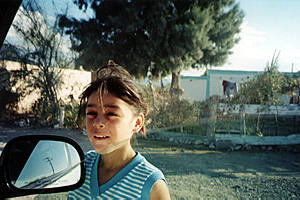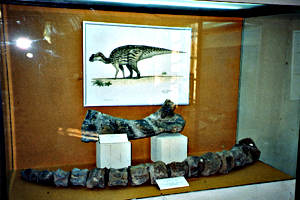January 1999 feature by Lauren Fielder |
|||||||||||||||||||||||||||||||||
|
Dos Dinosaurios y Tacos, Por Favor
There are probably at least six ways to approach a story about how dinosaurs and tacos convened in my conscious mind, however I'll take the high road this time and take the linear path, or the linea recto, if you will.
Having come from an absurdly traditional Midwestern American family (in spite of having a father born
and raised in Mexico), Thanksgiving meant nothing if not gathering up the family to eat an impossibly
large bird. The young kids would happily consume poultry while the older set would talk about all the old
folks in town who've since moved on to greener pastures or else just broken their hips. If someone was in a particularly rambunctious mood, you'd hear stories about priests who made nasty remarks, shop clerks
who "wouldn't give you the time of day," and teachers who were getting divorced, etc.
But nothing really stopped the eating. Not for me, anyway.
Well this year was quite different. My grandpa Lionel Gonzalez has long since left the ranch in San Blas, Mexico in the Western state of Nayarit and moved to Monterrey, Mexico, to be near family during his final winks and nods of life. So my husband Joe and I decided to pack up and head down to visit him. Being economy travelers, we arrived in Monterrey on Thanksgiving night around 11 p.m. and my cousin Rosaria and my father picked us up. She and dad escorted us on an extensive tour of Monterrey late that night before we all went to Jorge's Tacos for what was to Joe and I, traditionally speaking, a Thanksgiving dinner - but for them, any other meal (no, they don't celebrate the coming of white people in Mexico). So here I am, having Carne Asada instead of turkey or "bird" for Thanksgiving. But as we were eating, there was no talk of the local townspeople, or the grumpy shop owners, but rather of dinosaurios. Dinosaurs, which, by modern scientific theory, may be the ancestors to birds - even that mean, ugly beast we Americans eat each year ceremoniously. My cousin Laura promised to take Joe and I to Saltillo, in the next state over, Coahuila, to see huesos des dinosaurios or dinosaur bones. I began to wonder if I should have paid more attention during those Thanksgiving dinners at home all of those years- I might have missed some interesting opportunities. The next day was spent visiting my grandfather, meeting relatives, and eating even more food. Each meal was as good as the previous. Laura served us a traditional Northern Mexican breakfast each day consisting of an egg and bacon-like hash mixture, with frijoles and tortillas on the side, and a bowl of freshly sliced oranges and papayas. We visited and ate well into the evening, telling my sick grandfather about our planned trip the next day to Saltillo. He smiled and spoke slowly, in English with a conscious sprinkling of Spanish, of the beautiful mountains and sunsets in the area. Every few sentences he paused, sort of reflectively, and looked down at the blanket on his lap. I really wished, at that point, I had visited him long before, when he had his health, his ranch, and the outdoors he so appreciated throughout his life. We packed up the van with fresh fruit, water, nuts, our backpacks, and cameras and headed to Saltillo midday Saturday. Along the highway, Laura and my dad chatted about how Mexico has changed, what industry has done, good and bad, to the state of Coahuila as well as Monterrey's home state of Nueva Leon, as Joe and I sat and marveled at the landscape. The cactus, windmills, mules...and then we arrived in the area about 60 minutes outside of Saltillo, and about two hours outside of Monterrey known as the Rincon Colorado Museo de Paleontologia. 360 degrees around, in any direction, you could see nothing but hills, the subtle suggestion of the nape of the Sierra Madres, and a bright orange sun. A young girl ran up to our van and my cousin Laura quickly rolled down the electric window to greet her by name. The girl was holding up the curled foot of her shirt, which created a nest for at least two pounds of small fossils. She asked Laura in Spanish if we'd like to buy all of the fossilized shells and bits of "dinosaur skin" for a single peso, valued at about ten cents American. Laura suggested, instead, that the girl tour us through the dig site. She hopped in the van and we drove down a cinematically dusty trail blanketed with mules and cactus, to a small square that housed the actual museum. Now, I've always considered myself a skeptic. And worse than that, perhaps, is being a skeptic with optimistic undertones and a dangerous degree of curiosity. Naturally, walking into this single-story "museum" posed some serious questions. The Museo de Paleontologia where the public exhibit was housed occupied one room, about 15 by 30 feet. Some of the bones were fully exposed, and hanging on the wall with a painted mural of hypothetical dinosaur muscle and sinew underneath - displaying, educationally, how the bone may have fit within the dino's structure. Other bones and hunks of fossilized skin and shell were presented in small, rickety display cases that failed to be airtight, hence housing gnats, flys, and basically any critter small enough to squeeze through the eighth of an inch cracks. The museum "curators" on hand were two young Mexican girls that seemed about 16 or 18 years old. When we walked in, they were sitting on a small wooden table by the open door, swinging their legs and chatting back and forth. We didn't have to check our bags, sign in, or pick up a map, as none of this was necessary. It was more informal than a high school anthro lab, yet far more fascinating. We walked in circles, checking out the skin, then the tail bones, then the fossilized shells and back. But each time in a different order. It was hard to believe. My physical anthropology course at Washington University taught me that bones like this were extremely rare, and often protected by major universities or museums, such as the Smithsonian Institute or any one of many Natural History museums. We studied pictures in books, because our access to such items was so limited. We learned through professors and TAs with first-hand field experience of the struggles within the archeological world - who these finds belong to, which country owns rights to these, which huge, capitalist organization will win the control over these fossils. But here we were, in a small, dusty, friendly, local museum smaller than most post offices looking at evidence of the natural historical record.
The museum visit was followed by a trek to the actual dig sites. We spent about two hours digging through the dirt, picking up shells, and porous pieces of stone that may or may not have been the remains of some Cretaceous creature. Still, I didn't know what I was seeing. How could we be allowed to just forage like this? I asked my cousin Laura. "Well, if you find something, you have to report it to the Museum, and they report it to the Mexican Government." Simple enough. Around 6:30 p.m., the sun was setting behind the mountains, and the sky was a brilliant pink and orange, like one of those ridiculously tangy and sweet sherbet bars. We piled in the van, and drove our young guide back to her small, one-story stone and clay house, shaded by an immense cactus. Later that night, we had dinner with Laura and her husband Ramon. Having been an exemplary tour guide thus far, I figured Ramon would be able to better explain just how it is that we spent the day touching the very items the Smithsonian would certainly arrest us for merely breathing on. He told us that the Mexican government owns rights to any and all fossils and artifacts, and that the private sector, as well as universities and individuals, are not able to own such items as they belong to the country. Apparently, when the dinosaur bones were first found in Saltillo, as the story goes, some independent Japanese investors came in an gave the locals a small chunk of change for the majority of what had been found there - mostly dating from the Cretaceous period, up to about 70 million years ago. Then, the Mexican government stepped in to grab the rest. The locals wanted something (I'm guessing with the assistance of paleontologists who've worked in the region) to remain in Saltillo to generate tourism, hence, the Rincon Colorado Museo de Paleontologia was built and is maintained by the people who live in the town to this day. Upon returning to the States, my husband and I have done a fair amount of research into the region, and have discovered that Saltillo is no secret to paleontologists worldwide. As a matter of fact, an organization known as the DIS, or Dinamation International Society (http://www.dinamation.org) sponsors weekly expeditions to Saltillo and the Rincon Colorado center. These expeditions are led by expert paleontologists, professors, authors, and such, and use the site we visited for field work, teaching quarry management, map making and more. Several documentaries on the region are also available. It's pretty extraordinary, in retrospect, to have visited the site of such an important part of Mexico's natural history and fossil record, and to have not even realized its significance until afterwards. It's going to be tough to spend another Thanksgiving sitting around a table eating turkey, though, to be sure.
in the junk drawer |
|

















